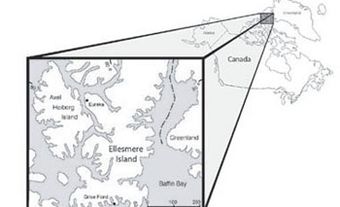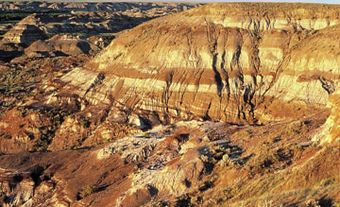The Joggins Fossil Cliffs are located in Nova Scotia, on the shores of Cumberland Basin in the upper Bay of Fundy. They contain an exceptional fossil record of the carboniferous period. In 2008, these cliffs were designated a UNESCO World Heritage Site.
History
The Joggins Fossil Cliffs have been a celebrated palaeontological site since the mid-19th century, when Sir Charles Lyell declared that the "forest of fossil coal-trees" exposed in the seaside cliffs was "the most wonderful phenomenon perhaps that I have seen." Lyell was born in Scotland and is the father of modern geology. His examination of this fossil forest settled the then hotly debated theory about the origin of coal, confirming that it was formed in place from the decayed matter of ancient forests. These 300-million-year-old trees were mostly lycopods, or scale trees, so named for the patterning on their bark. Ancestors of the present-day, diminutive club-mosses, these Coal Age (Carboniferous) giants grew to heights of 30 metres.
Lyell's second field trip to Joggins established Joggins as one of the most important fossil localities on the planet. He was accompanied by a young Nova Scotian, William Dawson, who later became Sir William and Canada's pre-eminent geologist of the 19th century. In 1852, Lyell and Dawson discovered in a fossilized tree trunk the remains of the earliest known reptile in the fossil record. A century and a half later, the lizard-sized animal, named Hylonomus lyelli, or "forest dweller," remains the oldest truly terrestrial creature ever found. It was trapped in a hollowed-out tree stump where it was preserved when muds from a meandering river system were washed into what Dawson dubbed "a strange repository."
The cliffs are exposed for several kilometres and are naturally quarried by the 12 m high Fundy tides. They continue to yield an almost inexhaustible supply of new and important fossils, including an array of early reptiles, amphibians and the earliest land snails. The preserved plants and animals document that epochal period in Earth's history when animals first evolved from the water onto land. The cliffs reveal the complete ecosystem of an ancient rainforest. Among the most dramatic trace fossils are the trackways of a 2 m long sow-bug-like creature, Arthropleura, which feasted on the abundant forest litter.
In 1843, the founder of the Geological Survey of Canada, Sir William Logan, chose Joggins as the site for the first survey conducted by his fledgling institution. The coal seams of the Cumberland Coal Basin were also mined commercially until 1980. Today, the Joggins Fossil Cliffs are prized for their scientific and cultural value alone. Many geologists believe that the cliffs preserve the most complete record of life in the Pennsylvanian Period (341 to 289 million years ago) anywhere in the world. For this reason, and because of its seminal role in the history of science, the Joggins Fossil Cliffs were designated a UNESCO World Heritage Site in 2008.
See also Paleontology.

 Share on Facebook
Share on Facebook Share on X
Share on X Share by Email
Share by Email Share on Google Classroom
Share on Google Classroom




